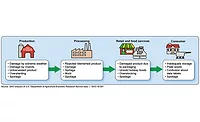Manufacturing News
Solving IoT supply chain communications problems

Standardized data will connect producers, inspectors and regulators, processors, supply chain participants and consumers to ensure food has met temperature, humidity, and food safety criteria from farm to fork.
Image: Natasha Hanacek, NIST.
Food manufacturers and distributors are beginning to attach IoT sensors to shipping containers to track critical information about the temperature and humidity of the product plus ongoing location and shipper information. But it wasn’t long ago there was no standardization of how these devices were to communicate with one another. Today, it’s a different story, and NIST (National Institute of Standards and Technology) has been a prime mover in getting standardization off the ground.
Moving food safely and efficiently around the U.S. and the world requires that food supply chain partners exchange important and timely information in a usable and expedient manner. However, to make that happen requires that the community of stakeholders (including food processors, IoT sensor/device makers and operators in the food supply chain) needs to find a meaningful and feasible way of representing that data to assure it is communicated and interpreted as intended, said Nenad Ivezic, leader of the Process Engineering Group in the Systems Integration Division of the NIST Engineering Laboratory in a NIST blog post.
NIST has been working with standards development organizations (SDOs) to bring together stakeholders from many industries and countries to design feasible ways to exchange data among their devices and systems at the supply chain level. One of the SDOs—Open Applications Group Inc. (OAGi)—has developed an open applications group integration specification (OAGIS) for several industries and taken on the task of enabling the necessary food-supply-chain standards by extending OAGIS to the food industry.
As might be expected, there were several hurdles to overcome, and OAGi partnered with NIST to address three main challenges. First, information exchange requirements from various food-supply-chain sources needed to be extracted and reconciled.
Second, the OAGIS standard is already serving many non-food industries, which use different terminologies depending on specific industry. According to Ivezic, the mismatches with existing terminology were typically due to the perishable nature of food products and the stringent regulations that must be followed to ensure food safety and traceability. This meant NIST experts had to reconcile the differences between the various OAGIS usage specifications in currently supported industry sectors.
Third, the existing OAGIS standard was in a different form than the one used by small IoT sensor and mobile devices, such as smartphones and tablets, to communicate. This meant the standard had to be represented in a completely new form, but also had to be in sync with the existing form. The team had to implement a new OAGIS expression to allow the new data formats used by mobile and IoT devices.
OAGi volunteers and NIST spent more than a year in developing a new version of its standard, OAGIS 10.4. The new standard is the result of input from NIST and industry partners, including Archer Daniels Midland, Land O’Lakes, Oracle and Boeing. The new standard has been successfully adopted into the food industry.
Scott Nieman, expert enterprise integration architect at Land O’Lakes, noted the improvements made after adopting the new standard along with the NIST-developed open-source software.
“We are seeing threefold improvement in productivity when using the NIST-enabled standards and software. These improvements in productivity are seen in data exchanges about orders and shipments and exchange of quality-related information for inspection and test results at Land O’Lakes factories and with its suppliers.”
Standardizing IIoT sensor communications
In an exclusive FE interview entitled “IIOT sensor communications issues still need work” (which can be found on the FE website), Ivezic says, “With introduction of IIoT, there is an unmet need to achieve integration of sensor data for enterprise-level business processes. Such enterprise-level business processes increasingly rely on data analytics to allow manufacturing systems to respond in real time to changing demands and conditions in the plant, supply network, and customer needs. Yet, presently, there is no documented standard and guideline to how such IIoT data should be conveyed to the manufacturing operation management level or the enterprise control level.”
To read Nenad Ivezic’s original blog, visit the NIST website..
Looking for a reprint of this article?
From high-res PDFs to custom plaques, order your copy today!







